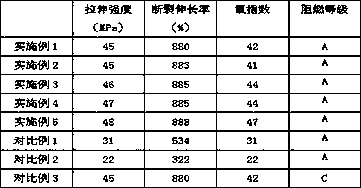PVC (Polyvinyl Chloride) power cable protective sleeve and preparation method thereof
A technology for power cables and sheath tubes, applied in the field of PVC power cable sheath tubes and its preparation, to achieve the effects of ensuring cross-linking effects, improving mechanical properties, and good toughness
- Summary
- Abstract
- Description
- Claims
- Application Information
AI Technical Summary
Problems solved by technology
Method used
Image
Examples
Embodiment 1
[0037] A kind of preparation method of PVC power cable sheath pipe, concrete steps are as follows:
[0038] (1) Evenly mix light calcium carbonate, silane coupling agent, coated red phosphorus masterbatch, ammonium polyphosphate and decabromodiphenyl ether to obtain the first material and set aside;
[0039] (2) Polyvinyl chloride (PVC), ethylene-vinyl acetate copolymer, styrene-butadiene block copolymer, thermoplastic polyester elastomer (TPEE) and polyarylether nitrile-polysiloxane block copolymerization Add the material into a high-speed mixer, stir at a low speed, add trioctyl trimellitate and di-sec-octyl phthalate, stir at a high speed, melt and blend at 70°C for 10 minutes, then add the first material obtained in step (1), and continue Stir at high speed to 90°C, and crosslink for 20 minutes at this temperature;
[0040] (3) Add alginate, lubricant and antistatic agent, and continue stirring at high speed for 10 minutes to obtain a mixture;
[0041] (4) adding the mix...
Embodiment 2
[0050] A kind of preparation method of PVC power cable sheath pipe, concrete steps are as follows:
[0051] (1) Evenly mix light calcium carbonate, silane coupling agent, coated red phosphorus masterbatch, ammonium polyphosphate and decabromodiphenyl ether to obtain the first material and set aside;
[0052] (2) Polyvinyl chloride (PVC), ethylene-vinyl acetate copolymer, styrene-butadiene block copolymer, thermoplastic polyester elastomer (TPEE) and polyarylether nitrile-polysiloxane block copolymerization Add the material into a high-speed mixer, stir at a low speed, add trioctyl trimellitate and di-sec-octyl phthalate, stir at a high speed, melt and blend at 75°C for 15 minutes, then add the first material obtained in step (1), and continue Stir at high speed to 95°C, and crosslink for 25 minutes at this temperature;
[0053] (3) Add alginate, lubricant and antistatic agent, and continue stirring at high speed for 12 minutes to obtain a mixture;
[0054] (4) adding the mix...
Embodiment 3
[0063] A kind of preparation method of PVC power cable sheath pipe, concrete steps are as follows:
[0064] (1) Evenly mix light calcium carbonate, silane coupling agent, coated red phosphorus masterbatch, ammonium polyphosphate and decabromodiphenyl ether to obtain the first material and set aside;
[0065] (2) Polyvinyl chloride (PVC), ethylene-vinyl acetate copolymer, styrene-butadiene block copolymer, thermoplastic polyester elastomer (TPEE) and polyarylether nitrile-polysiloxane block copolymerization Add the material into a high-speed mixer, stir at a low speed, add trioctyl trimellitate and di-sec-octyl phthalate, stir at a high speed, melt and blend at 70°C for 15 minutes, then add the first material obtained in step (1), and continue Stir at high speed to 90°C, and crosslink for 25 minutes at this temperature;
[0066] (3) Add alginate, lubricant and antistatic agent, and continue stirring at high speed for 10 minutes to obtain a mixture;
[0067] (4) adding the mix...
PUM
| Property | Measurement | Unit |
|---|---|---|
| The average particle size | aaaaa | aaaaa |
| Particle size | aaaaa | aaaaa |
Abstract
Description
Claims
Application Information
 Login to View More
Login to View More - Generate Ideas
- Intellectual Property
- Life Sciences
- Materials
- Tech Scout
- Unparalleled Data Quality
- Higher Quality Content
- 60% Fewer Hallucinations
Browse by: Latest US Patents, China's latest patents, Technical Efficacy Thesaurus, Application Domain, Technology Topic, Popular Technical Reports.
© 2025 PatSnap. All rights reserved.Legal|Privacy policy|Modern Slavery Act Transparency Statement|Sitemap|About US| Contact US: help@patsnap.com

